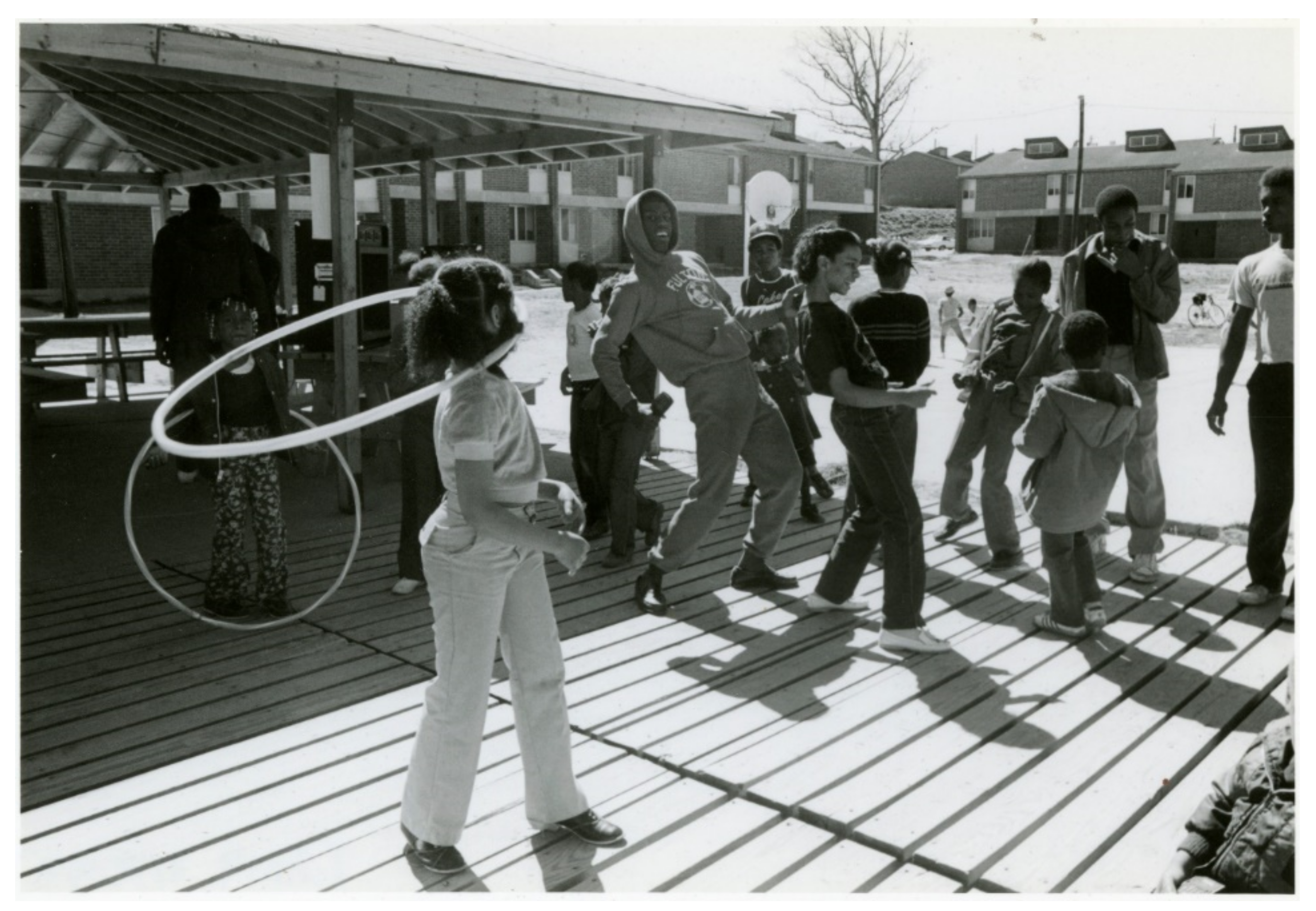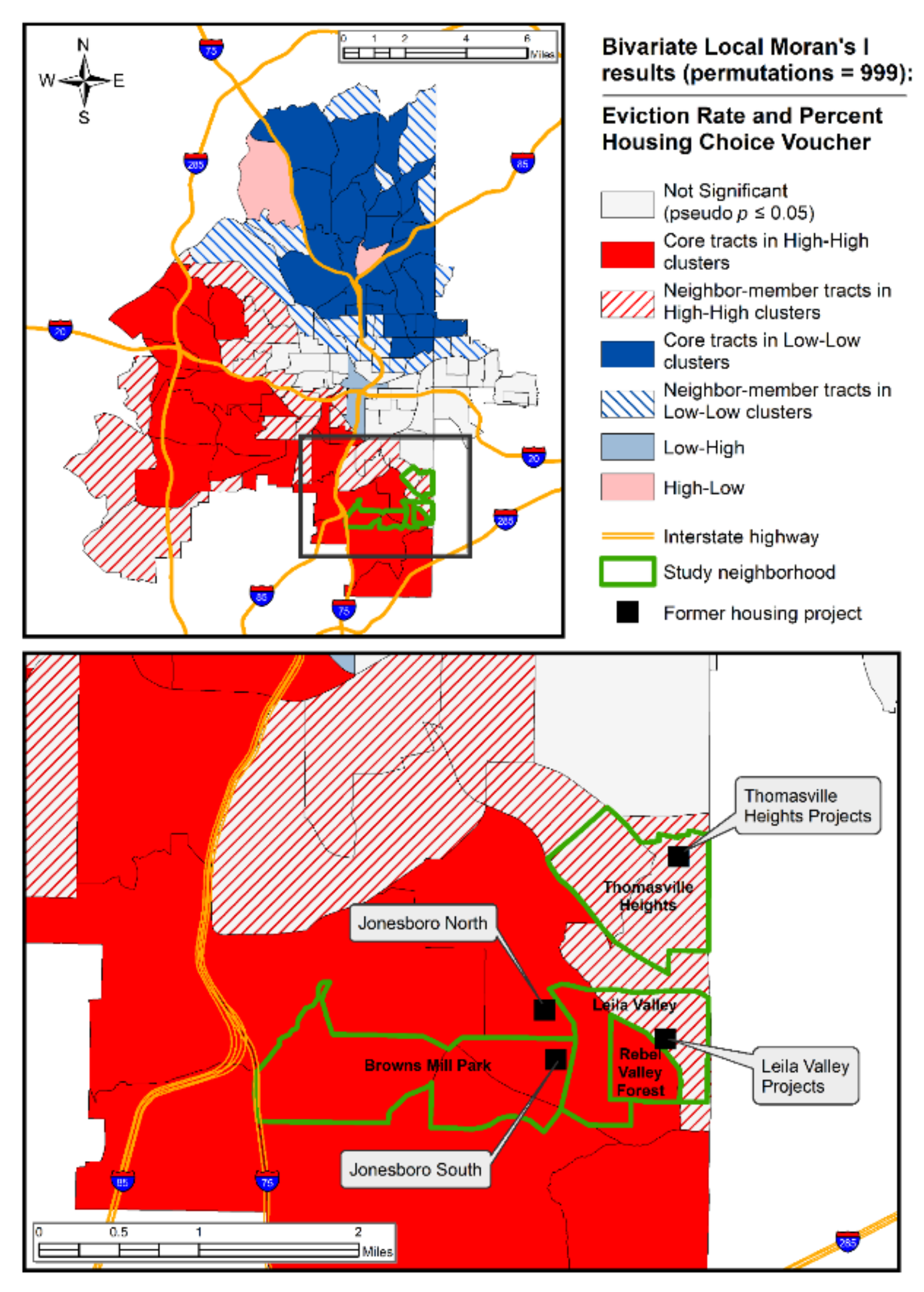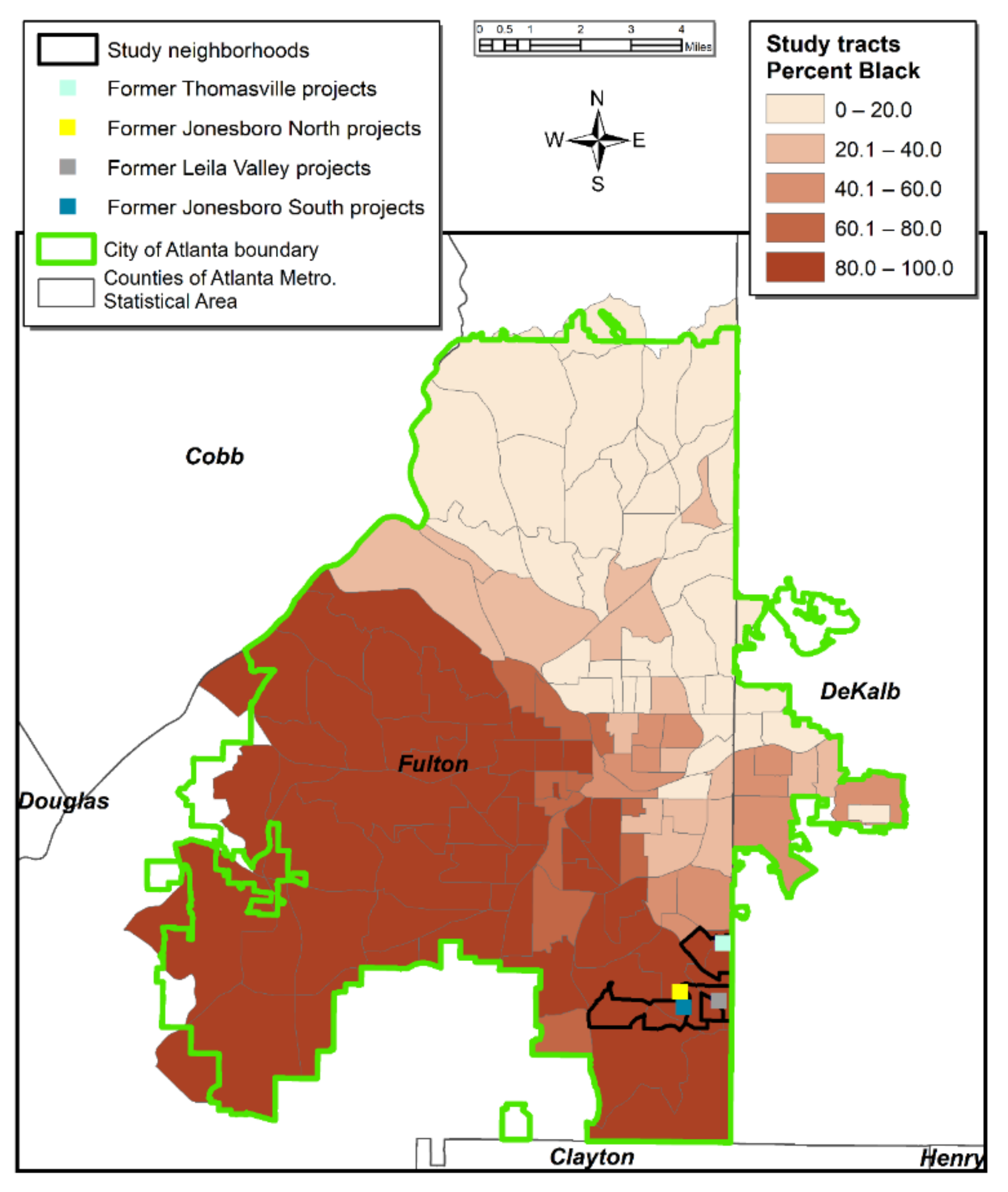Exploring Transiency in Four Urban Forest Patch Neighborhoods: Atlanta, Georgia, USA
Abstract
:1. Introduction
2. Literature Review
2.1. Greenspace Civic Activism
2.2. Public Housing Projects and Adjacent Neighborhoods
2.3. Neighborhood Transiency
3. Materials and Methods
3.1. Informant Impressions of Urban Patch Neighborhoods: Unstructured Conversations
3.2. Neighborhood Transiency: Local Indicators of Spatial Association (LISA) Analysis
4. Results
4.1. Informant Impressions of Forest Patch Neighborhoods
They sold [home owning neighbors], the family ended up selling the house to…investors. And the investors brought in Section 8 [HCV households]. And I don’t have a problem with Section 8. But they just threw them in there…. These people, probably because they’re so young…, they didn’t have that same buy-in to the community. And so that, “It’s-not-mine-I-ain’t-got-to-take care-of-it”—they brought that same thing to the community[30].
4.2. Neighborhood Transiency: Bivariate LISA Analysis
5. Discussion
Author Contributions
Funding
Institutional Review Board Statement
Informed Consent Statement
Data Availability Statement
Acknowledgments
Conflicts of Interest
Appendix A
I-Tree Hydro Simulations
| Parcel | Parcel Acreage (ha) | Landcover Scenario | Total Runoff (m3/yr) | Pervious Flow (m3/yr) | Impervious Flow (m3/yr) |
|---|---|---|---|---|---|
| Jonesboro North | 9.28 (3.76) | 2007 | 31,136 | 24,614 | 5507 |
| 2020 | 19,290 | 15,830 | 0 | ||
| Jonesboro South | 15.0 (6.07) | 2007 | 46,631 | 38,875 | 24,704 |
| 2020 | 30,464 | 24,704 | 0 | ||
| 2020 | 17,052 | 11,624 | 346 | ||
| Leila Valley | 14.0 (5.67) | 2007 | 22,328 | 16,679 | 2863 |
| 2020 | 17,052 | 11,624 | 346 | ||
| Thomasville | 36.42 (14.74) | 2007 | 123,768 | 93,375 | 17,096 |
| 2020 | 87,001 | 60,646 | 32 |
| Parcel | Landcover Scenario | TSS (kg/yr) | BOD (kg/yr) | COD (kg/yr) | TP (kg/yr) | SolP (kg/yr) | TKN (kg/yr) | NO2− & NO3− (kg/yr) | Cu (kg/yr) | Pb (kg/yr) | Zn (kg/yr) |
|---|---|---|---|---|---|---|---|---|---|---|---|
| Jonesboro North | 2007 | 2315.31 | 416.40 | 1559.29 | 9.30 | 3.81 | 51.09 | 19.43 | 0.40 | 1.99 | 4.78 |
| 2020 | 1240.86 | 223.16 | 835.68 | 4.99 | 2.04 | 27.38 | 10.41 | 0.21 | 1.07 | 2.56 | |
| Jonesboro South | 2007 | 3563.37 | 640.86 | 2399.82 | 14.32 | 5.86 | 78.63 | 29.91 | 0.61 | 3.07 | 7.36 |
| 2020 | 1980.68 | 356.22 | 1333.93 | 7.96 | 3.26 | 43.71 | 16.62 | 0.34 | 1.71 | 4.09 | |
| Leila Valley | 2007 | 1532.16 | 275.55 | 1031.86 | 6.16 | 2.52 | 33.81 | 12.86 | 0.26 | 1.32 | 3.17 |
| 2020 | 938.41 | 168.77 | 631.99 | 3.77 | 1.54 | 20.71 | 7.88 | 0.16 | 0.81 | 1.94 | |
| Thomasville | 2007 | 8660.88 | 1557.63 | 5832.83 | 34.80 | 14.25 | 191.11 | 72.69 | 1.49 | 7.46 | 17.90 |
| 2020 | 4757.12 | 855.55 | 3203.77 | 19.11 | 7.83 | 104.97 | 39.93 | 0.82 | 4.10 | 9.83 |
References
- Giarrusso, T.; Smith, S. Assessing Urban Tree Canopy in the City of Atlanta: A Baseline Canopy Study; Development Arborist Division: Atlanta, GA, USA, 2014. Available online: https://www.atlantaga.gov/Home/ShowDocument?id=14722 (accessed on 25 February 2017).
- Atlanta Housing. Atlanta Housing FY 2021 Moving to Work (MTW) Annual Report. Available online: https://www.atlantahousing.org/wp-content/uploads/2021/10/HA-GA006-FY2021-Ann.-MTW-Report.pdf (accessed on 1 April 2022).
- Atlanta Housing. Atlanta Housing FY 2018 MTW [Moving to Work] Annual Report: For Fiscal Year Ending 30 June 2018; Atlanta Housing: Atlanta, GA, USA, 2018; Available online: https://www.atlantahousing.org/wp-content/uploads/2018/12/AtlantaHousing-FY2018-MTW-Annual-Report-Board-Approved-FINAL-2018.0928ForWeb.pdf (accessed on 15 July 2020).
- Mcnulty, T.; Holloway, S. Race, Crime, and Public Housing in Atlanta: Testing a Conditional Effect Hypothesis. Soc. Forces 2000, 79, 707–729. [Google Scholar] [CrossRef]
- Burns, S.; McMahon, D. East Lake Meadows. 2021. Available online: https://kenburns.com/films/east-lake-meadows-a-public-housing-story/ (accessed on 1 April 2022).
- Ernstson, H. The Social Production of Ecosystem Services: A Framework for Studying Environmental Justice and Ecological Complexity in Urbanized Landscapes. Landsc. Urban Plan. 2013, 109, 7–17. [Google Scholar] [CrossRef] [Green Version]
- Campbell, L.K.; Svendsen, E.S.; Johnson, M.L.; Plitt, S. Not by Trees Alone: Centering Community in Urban Forestry. Landsc. Urban Plan. 2022, 224, 104445. [Google Scholar] [CrossRef]
- Johnson, M.L.; Campbell, L.K.; Svendsen, E.S.; Silva, P. Why Count Trees? Volunteer Motivations and Experiences with Tree Monitoring in New York City. Arboric. Urban For. 2018, 44, 59–72. [Google Scholar] [CrossRef]
- Jelks, N.O.; Hawthorne, T.L.; Dai, D.; Fuller, C.H.; Stauber, C. Mapping the Hidden Hazards: Community-Led Spatial Data Collection of Street-Level Environmental Stressors in a Degraded, Urban Watershed. Int. J. Environ. Res. Public. Health 2018, 15, 825. [Google Scholar] [CrossRef] [PubMed] [Green Version]
- Saliminen Witt, R.; Svendsen, E.; Krasny, M. Civic Stewardship as a Catalyst for Social-Ecological Change in Detroit, Michigan. In Grassroots to Global: Broader Impacts of Civic Ecology; Cornell University Press: New York, NY, USA, 2018; pp. 213–230. [Google Scholar] [CrossRef]
- Desmond, M.; Kimbro, R.T. Eviction’s Fallout: Housing, Hardship, and Health. Soc. Forces 2015, 94, 295–324. [Google Scholar] [CrossRef]
- Shelton, T. Mapping Dispossession: Eviction, Foreclosure and the Multiple Geographies of Housing Instability in Lexington, Kentucky. Geoforum 2018, 97, 281–291. [Google Scholar] [CrossRef]
- Rotolo, T.; Wilson, J.; Hughes, M.E. Homeownership and Volunteering: An Alternative Approach to Studying Social Inequality and Civic Engagement. Sociol. Forum 2010, 25, 570–587. [Google Scholar] [CrossRef]
- Gustafson, S. Displacement and The Racial State in Olympic Atlanta 1990–1996. Southeast. Geogr. 2013, 53, 198–213. [Google Scholar] [CrossRef]
- Schank, K.M. Producing the Projects: Atlanta and the Cultural Creation of Public Housing, 1933–2011. Ph.D. Thesis, ProQuest National Agriculture Library—Dissertation. The George Washingtion University, Washington, DC, USA, 2016. Available online: https://www.proquest.com/docview/1779975993?pq-origsite=gscholar&fromopenview=true (accessed on 29 March 2021).
- Goldstein, A. A Purposely Built Community: Public Housing Redevelopment and Resident Replacement at East Lake Meadows. Atlanta Studies. Available online: https://atlantastudies.org/2017/03/14/a-purposely-built-community-public-housing-redevelopment-and-resident-replacement-at-east-lake-meadows/ (accessed on 25 March 2022).
- Oakley, D.; Ruel, E.; Wilson, G.E. A Choice with No Options: Atlanta Public Housing Residents’ Lived Experiences in the Face of Relocation. p. 34. Available online: http://www.thecyberhood.net/documents/projects/atlanta.pdf (accessed on 25 March 2022).
- Nations, H. Most Public Housing in Small Area. The Atlanta Journal Constitution, 4 April 1971. [Google Scholar]
- Immergluck, D.; Carpenter, A.; Lueders, A. Hot City, Cool City: Explaining Neighbourhood-Level Losses in Low-Cost Rental Housing in Southern US Cities. Int. J. Hous. Policy 2018, 18, 454–478. [Google Scholar] [CrossRef]
- Immergluck, D. The Role of Investors in the Single-Family Market in Distressed Neighborhoods: The Case of Atlanta; Joint Center for Housing Studies: Cambridge, MA, USA, 2013; Available online: https://www.jchs.harvard.edu/research-areas/working-papers/role-investors-single-family-market-distressed-neighborhoods-case (accessed on 26 March 2022).
- Neighborhood Nexus. City of Atlanta Neighborhoods. Available online: https://neighborhoodnexus.org/dashboard/city-of-atlanta/ (accessed on 12 December 2021).
- DeLuca, S.; Wood, H.; Rosenblatt, P. Why Poor Families Move (And Where They Go): Reactive Mobility and Residential Decisions. City Community 2019, 18, 556–593. [Google Scholar] [CrossRef]
- Raymond, E.; Duckworth, R.; Miller, B.; Lucas, M.; Pokharel, S. Corporate Landlords, Institutional Investors, and Displacement: Eviction Rates in Single-Family Rentals. 2016, p. 22. Available online: https://www.atlantafed.org/-/media/documents/community-development/publications/discussion-papers/2016/04-corporate-landlords-institutional-investors-and-displacement-2016-12-21.pdf (accessed on 16 October 2020).
- Wang, R.; Walter, R.J. Tracking Mobility in the Housing Choice Voucher Program: A Household Level Examination in Florida, USA. Hous. Stud. 2018, 33, 455–475. [Google Scholar] [CrossRef]
- Desmond, M. Eviction and the Reproduction of Urban Poverty. Am. J. Sociol. 2012, 118, 88–133. [Google Scholar] [CrossRef] [Green Version]
- Princeton University Eviction Laboratory. Eviction and Eviction Rate. Available online: https://evictionlab.org/rankings/#/evictions (accessed on 5 July 2020).
- Briggs, X.d.S.; Comey, J.; Weismann, G. Struggling to Stay out of High-Poverty Neighborhoods: Housing Choice and Locations in Moving to Opportunity’s First Decade. Hous. Policy Debate 2010, 20, 383–427. [Google Scholar] [CrossRef]
- Lundberg, I.; Gold, S.L.; Donnelly, L.; Brooks-Gunn, J.; McLanahan, S.S. Government Assistance Protects Low-Income Families from Eviction. J. Policy Anal. Manag. 2021, 40, 107–127. [Google Scholar] [CrossRef] [PubMed]
- Desmond, M.; Shollenberger, T. Forced Displacement From Rental Housing: Prevalence and Neighborhood Consequences. Demography 2015, 52, 1751–1772. [Google Scholar] [CrossRef] [PubMed]
- Allen, L.J. Planning Atlanta—A New City in the Making, 1930s–1990s. Norwood Manor Civic Association Oral History Interview. 29 January 2015. Available online: https://digitalcollections.library.gsu.edu/digital/collection/PlanATL/id/2805/rec/1 (accessed on 30 March 2022).
- Allen, L.J. Planning Atlanta—A New City in the Making, 1930s–1990s. Thomasville Group Oral History Interview. 12 March 2015. Available online: https://digitalcollections.library.gsu.edu/digital/collection/planatl/search/searchterm/joy%20allen (accessed on 18 March 2022).
- US Department of Housing and Urban Development, Office of Policy Development and Research (PD&R). Enterprise Geospatial Information System (eGIS). Housing Choice Vouchers by Tract. Available online: http://hudgis-hud.opendata.arcgis.com/datasets/housing-choice-vouchers-by-tract?geometry=-96.248%2C-0.614%2C-147.224%2C76.538 (accessed on 28 July 2020).
- US Census Bureau. TIGER/Line Shapefiles 2018. Available online: https://www.census.gov/geographies/mapping-files/time-series/geo/tiger-line-file.2018.html (accessed on 8 July 2020).
- City of Atlanta, Department of City Planning GIS. Atlanta City Limits; Department of City Planning Geographic Information Systems (GIS): Atlanta, GA, USA, 2021; Available online: https://dpcd-coaplangis.opendata.arcgis.com/datasets/atlanta-city-limits/explore?location=33.728850%2C-84.448300%2C9.29 (accessed on 2 June 2022).
- Anselin, L. Local Indicators of Spatial Association—LISA. Geogr. Anal. 1995, 27, 93–115. Available online: https://onlinelibrary.wiley.com/doi/abs/10.1111/j.1538-4632.1995.tb00338.x (accessed on 23 March 2022). [CrossRef]
- Anselin, L. A Local Indicator of Multivariate Spatial Association: Extending Geary’s c. Geogr. Anal. 2019, 51, 133–150. [Google Scholar] [CrossRef]
- Anselin, L.; Li, X. Tobler’s Law in a Multivariate World. Geogr. Anal. 2020, 52, 494–510. [Google Scholar] [CrossRef]
- GeoDa on Github. Available online: https://geodacenter.github.io/ (accessed on 25 March 2022).
- Wang, J.; Endreny, T.A.; Nowak, D.J. Mechanistic Simulation of Tree Effects in an Urban Water Balance Model. J. Am. Water Resour. Assoc. 2008, 44, 75–85. [Google Scholar] [CrossRef]




Publisher’s Note: MDPI stays neutral with regard to jurisdictional claims in published maps and institutional affiliations. |
© 2022 by the authors. Licensee MDPI, Basel, Switzerland. This article is an open access article distributed under the terms and conditions of the Creative Commons Attribution (CC BY) license (https://creativecommons.org/licenses/by/4.0/).
Share and Cite
Johnson Gaither, C.; Cross, D.A.; Dobbs, G.R. Exploring Transiency in Four Urban Forest Patch Neighborhoods: Atlanta, Georgia, USA. Sustainability 2022, 14, 7220. https://doi.org/10.3390/su14127220
Johnson Gaither C, Cross DA, Dobbs GR. Exploring Transiency in Four Urban Forest Patch Neighborhoods: Atlanta, Georgia, USA. Sustainability. 2022; 14(12):7220. https://doi.org/10.3390/su14127220
Chicago/Turabian StyleJohnson Gaither, Cassandra, Denzell A. Cross, and G. Rebecca Dobbs. 2022. "Exploring Transiency in Four Urban Forest Patch Neighborhoods: Atlanta, Georgia, USA" Sustainability 14, no. 12: 7220. https://doi.org/10.3390/su14127220
APA StyleJohnson Gaither, C., Cross, D. A., & Dobbs, G. R. (2022). Exploring Transiency in Four Urban Forest Patch Neighborhoods: Atlanta, Georgia, USA. Sustainability, 14(12), 7220. https://doi.org/10.3390/su14127220





